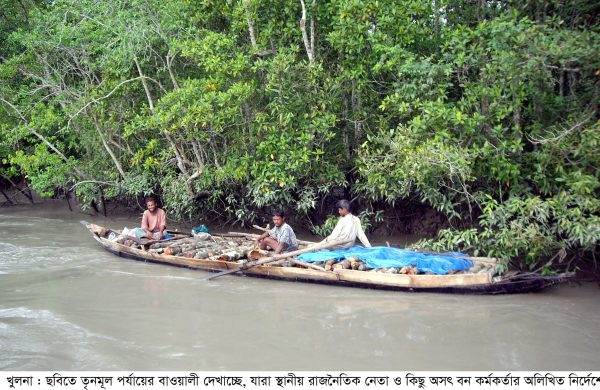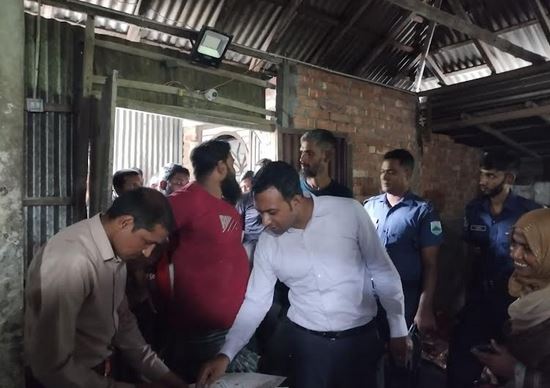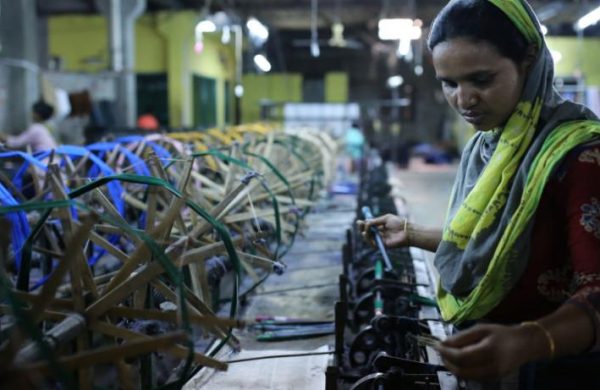Rampant plundering of ‘Sundari’ trees threats Sundarbans
- Update Time : Saturday, June 21, 2025

Hosneara Parvin Khuku from Khulna:
The plundering of valuable ‘Sundari’ trees, which are essential to the character of the Sundarbans, is occurring indiscriminately that threatening the biodiversity of the world’s largest mangrove reserve forest on the top of nose of the authorities concerned. But, there is no one to see the matter.
As a result, agitation has been created among the civil society members as well as political leaders and activists in the region.
They urged the authorities concerned to take immediate steps to prevent looting of the valuable trees with the aim to protect the biodiversity of the country’s largest mangrove forest.
Advocate Md Babul Hawlader, the Member Secretary of Khulna Nagorik Samaj said, “A group of influential traders in collaboration with some unscrupulous forest officers and local political leaders have been looting precious plants throughout the year and are making money by smuggling those to different places.
He alleged that smugglers have managed to corrupt various levels of the forest department, and local law enforcement is not beyond their influence. They bribe officials with substantial sums of money to carry out their activities without restraint.
Timber smugglers transport illegal ‘Sundari’ logs using engine boats to sawmills at night, where they immediately split the wood to evade detection by law enforcement. Sources indicate that each trip can yield several lakh taka worth of smuggled wood. The smugglers also spread fear of tigers and forest robbers among villagers to make the forest appear deserted, facilitating their looting operations.
The Sundarbans span approximately 10,000 square kilometres, including the Indian portion in West Bengal. The Bangladeshi section covers 6,017 square kilometres, located south of the Khulna, Bagerhat, and Satkhira districts along the Bay of Bengal. Of this area, 4,143 square kilometres is land, including 1,874 square kilometres of water.
The Sundari tree, which is the principal species in the Sundarbans, makes up around 70% of the total plant and tree population in the forest. An unofficial census estimates that approximately 857 million ‘Sundari’ trees exist in the Sundarbans.
Sanjoy Saha, Chief Scientific Officer of the Institute for Integrated Studies on the Sundarbans and Coastal Ecosystem (IISSCE) at Khulna University, noted that a ‘Sundari’ tree typically lives for about 150 years and reaches maturity at around 40 years. Besides Sundari trees, Gewa wood comprises 16% of the forest area, while the remaining 11% includes Pashur, Garan, Kewra, Dhundal, Kakra, Bain, Golpata, Shingra, Bola, Hetal, Khalshi, Hargoza, Dhanshi, and various other trees.
On average, four to six forest officials are stationed at each camp in the Sundarbans. However, these guards, armed only with three-notch rifles, are unable to resist organized groups of pirates who carry sophisticated weapons. A forester, who wished to remain anonymous, stated that organized robbers, poachers, and illegal loggers have taken control of vast areas of the Sundarbans, plundering its resources.
An unofficial survey report revealed that ‘Sundari’ timber worth about Tk50 lakh is being smuggled out of the forest each month from its eastern and western wings. Consequently, this world heritage mangrove forest is being gradually denuded.
At night, multiple engine boats and vehicles are reported to enter the forests, illegally cutting down trees and transporting the timber to various destinations.
Kawsar Dhali, a three-wheeler driver, noted, “The smugglers are very organized and come to the forest in groups. They are powerful and maintain connections with high-ranking officials. They carry firearms and lethal weapons when they enter the forest.”
AZM Hasanur Rahman, the District Forest Officer (DFO) of the Sundarbans West division, stated that, “Our main goal is to ensure the security of wildlife, fishermen, and bawalis, who represent significant revenue sources.”
He also mentioned that he has received information about wood smuggling from different sources, but not all reports are credible. He vowed to take action if he obtained conclusive proof of forest guards’ involvement in the operations.
Local residents claim they feel helpless to resist the looting of wood, as the authorities of the Forest Department and the district administration seem to be ignoring the growing menace.













